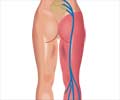Many more patients with chronic pancreatitis can safely turn to a minimally invasive operation for long-term pain relief, according to a new study by
Many more patients with chronic pancreatitis can safely turn to a minimally invasive operation for long-term pain relief, according to a new study by Johns Hopkins University physicians.
Endoscopic therapy is an effective alternative to more invasive surgery or drugs, says Anthony N. Kalloo, MD, director of GI endoscopy at Hopkins and lead author of the study that appeared in the July 2000 issue of Gastrointestinal Endoscopy."Chronic pancreatitis, long-term inflammation of the pancreas, affects up to 5% of the United States population. Caused by various factors including alcoholism, the disease creates severe and even crippling upper-abdominal and back pain. In many cases, Kalloo says, pain may be caused by elevated pressures in the pancreatic duct. For these patients, endoscopic therapy that includes endoscopic pancreatic sphincterotomy (EPS), in which surgeons cut the sphincter muscle at the end of the pancreatic duct to release pressure, has proven effective in the short term, but the Hopkins study was designed to assess its long-term value. The doctors discovered that 62% of the patients reported significant improvement in their pain, with significant improvement defined as a greater than 50% decrease in pain score











